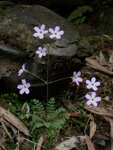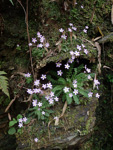P. jiugongshanensis J.W.Shao
Section Ranunculoides
Type specimen: J.W. Shao and D.Y.Wang 20110427007 resides at ANUB (Specimen ANUB13043050).
Epithet: Named for Mt. Jiugongshan where the type specimen was collected.
Distribution: Hubei, China.
This species is compared with other members of the same section: P. ranunculoides, P. merrilliana and P. cicutariifolia but differentiated by genetic analysis. It also differs from P. cicutariifolia by having distylous flowers (as opposed to homostylous), from P. merrilliana by emarginate corolla lobes (as opposed to rounded) and P. ranunculoides which has the additional ability to reproduce asexually via bulblets. P. hubeiensis is also found in the area but differs in being hairy (P. jiugongshanensis is glabrous). This species is a biennial, with young leaves simple, toothed and ovate, older leaves pinnatisect with 7-19 pinnae, the terminal pinnae similar to the other, usually 3 lobed. Scapes 1-10 per plant usually with a single umbel or 2 (3) umbels superimposed, with 3 (2) flowers per umbel. Flowers distylous, purple or lilac with a yellow eye surrounded by a white zone. Calyx narrowly campanulate, cut past the middle into lanceolate lobes. Found growing on the northern slope of a limestone hill under broadleaf deciduous forest.











